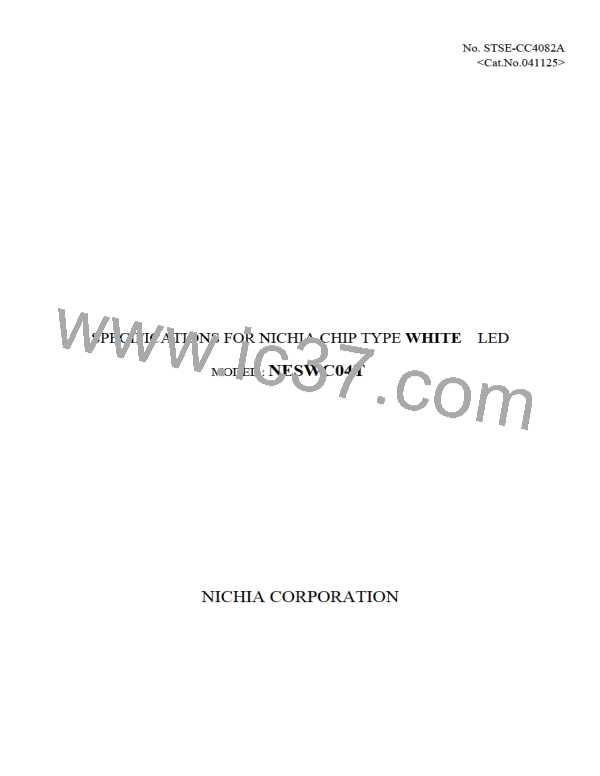Nichia STSE-CC4082A
<Cat.No.041125>
(6) Static Electricity
· Static electricity or surge voltage damages the LEDs.
It is recommended that a wrist band or an anti-electrostatic glove be used when handling the LEDs.
· All devices, equipment and machinery must be properly grounded.
It is recommended that measures be taken against surge voltage to the equipment that mounts the LEDs.
· When inspecting the final products in which LEDs were assembled, it is recommended to check
whether the assembled LEDs are damaged by static electricity or not.
It is easy to find
static-damaged LEDs by a light-on test or a VF test at a lower current (below 1mA is recommended).
· Damaged LEDs will show some unusual characteristics such as the leak current remarkably
increases, the forward voltage becomes lower, or the LEDs do not light at the low current.
(7) Others
· It is requested to avoid any stress added to the resin portion while it is heated.
· It is requested to avoid any friction by sharp metal nail etc, to the resin portion.
· The current limiting resistor should be placed in the circuit in order for LED to work within its rating.
Also avoid reverse voltage (overcurrent) applied instantaneously when ON or OFF.
· When assembling the circuit board into the finished products, care must be taken to avoid the component
parts from touching other parts.
· The LED light output is strong enough to injure human eyes. Precautions must be taken to prevent
looking directly at the LEDs with unaided eyes for more than a few seconds.
· Flashing lights have been known to cause discomfort in people; you can prevent this by taking
precautions during use. Also, people should be cautious when using equipment that has had LEDs
incorporated into it.
· The LEDs described in this brochure are intended to be used for ordinary electronic equipment (such
as office equipment, communications equipment, measurement instruments and household appliances).
Consult Nichia’s sales staff in advance for information on the applications in which exceptional quality
and reliability are required, particularly when the failure or malfunction of the LEDs may directly
jeopardize life or health (such as for airplanes, aerospace, submersible repeaters, nuclear reactor
control systems, automobiles, traffic control equipment, life support systems and safety devices).
· User shall not reverse engineer by disassembling or analysis of the LEDs without having prior written
consent from Nichia. When defective LEDs are found, the User shall inform Nichia directly before
disassembling or analysis.
· The formal specifications must be exchanged and signed by both parties before large volume purchase begins.
· The appearance and specifications of the product may be modified for improvement without notice.
-6-

 NICHIA [ NICHIA CORPORATION ]
NICHIA [ NICHIA CORPORATION ]